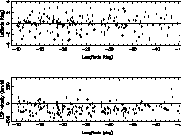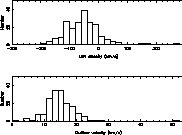The data were reduced as described in Paper I, using the reduction
package Miriad (Sault et al. 1995).
The data were searched with an adapted version of the CLEAN algorithm,
fully described in Appendix A of Paper I. This was performed on
a Cray-C98.
During the observations for the Disk region,
especially its parts furthest away from the
galactic Centre, considerable narrow-band radio-frequency
interference (RFI) was present.
To minimize this,
we performed two steps of removal of RFI. Before
any searching of the data we automatically traced and flagged any
time-cuts that contained RFI spikes. After removal
of the brightest sources, we fitted 11![]() -order polynomials
(UVLIN routine in Miriad, Sault 1994, see Paper I)
to all visibilities in order
to remove wide-band RFI. In part B of the Disk region
hardly any narrow-band RFI was found present, however,
in part A
severe narrow-band RFI was present in
-order polynomials
(UVLIN routine in Miriad, Sault 1994, see Paper I)
to all visibilities in order
to remove wide-band RFI. In part B of the Disk region
hardly any narrow-band RFI was found present, however,
in part A
severe narrow-band RFI was present in ![]() 20% of the fields.
After flagging the time-cuts with RFI, the serviceable integration time
on these fields was reduced on average by
20% of the fields.
After flagging the time-cuts with RFI, the serviceable integration time
on these fields was reduced on average by ![]() 30% (see Fig. 1).
Still, even in the fields with shortest integration times, the integration
times are similar to those in the Bulge region (Paper I).
The source-finding algorithm is as described in the appendix of Paper I.
The lowest level of searching was performed with minimum flux density
of 90 mJy. The cell sizes used are
30% (see Fig. 1).
Still, even in the fields with shortest integration times, the integration
times are similar to those in the Bulge region (Paper I).
The source-finding algorithm is as described in the appendix of Paper I.
The lowest level of searching was performed with minimum flux density
of 90 mJy. The cell sizes used are ![]() in the first
two passes of source finding and
in the first
two passes of source finding and ![]() in subsequent passes.
in subsequent passes.

Figure 2:
The longitude-latitude and longitude-velocity distributions
for all the sources in the galactic Disk region

Figure 3:
The histograms of the line-of-sight velocity and the
expansion velocity of all the sources in the galactic Disk region.
The mean expansion velocity is ![]()